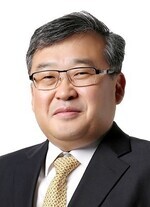hankyoreh
Links to other country sites 다른 나라 사이트 링크
[Guest essay] For Korea’s own sake, it’s time we talk about opening up immigration


By Jo Kung-ho, senior secretary to the speaker of the National Assembly for political affairs
“I was born in Tehran and brought by my parents to a small village in Norway at the age of five. In the land of opportunity that was Norway, the fact that I had this unusual name of ‘Masud Gharahkhani’ wasn’t any kind of stumbling block in my community, and I was able to achieve my dream through my efforts alone.”
This excerpt is from a speech delivered at a convention of the Norwegian Labour Party in 2011, when Masud Gharahkhani was a first-term lawmaker in the Storting, as the country’s parliament is known. Today, Gharahkhani — who paid a courtesy visit to South Korea’s National Assembly Speaker Kim Jin-pyo last February — serves as president of the Storting.
The speech made him a star overnight, and 10 years later he became the first overseas-born immigrant in history to lead Norway’s supreme legislature. His story evokes feelings of déjà vu with its parallels to that of Barack Obama, who captured the public’s hearts with his Democratic Party convention speech in 2004 as an Illinois senator and ended up elected president four years later.
The president of Norway’s Storting, a 40-year-old child of immigrants! Perhaps that explains how Norway, land of the Nobel Prize and the aurora borealis, could become a Scandinavian welfare state. An open society that accepts people regardless of their appearance and empowers them to maximize their abilities seems to be what has made Norway the envy of the world.
Here’s another example.
When the world was panicking over the spread of COVID-19, a novel mRNA vaccine was developed that was manufactured with proteins, unlike previous vaccines. The scientists who came up with that method were a German couple by the name of Ugur Sahin and Özlem Türeci, both second-generation immigrants from Türkiye.
Germany welcomes in immigrants even though its 2021 total fertility rate was 1.58, much higher than Korea’s. Around 80% of foreign university graduates who are allowed into Europe through the EU Blue Card program are allotted to Germany.
Germany prioritizes experts in the so-called MINT fields — that is, mathematics, information science, natural science and technology. Toward that end, Germany enacted legislation paving the way for the immigration of professionals in 2019. Then on March 29, the German federal government passed another law streamlining immigration for skilled workers in fields with a labor shortage such as information technology, medical care, childcare and other forms of care.
Since 2006, Korea has poured more than 300 trillion won of public funds into programs under the Framework Act on Low Birth Rate in an Aging Society, but the birth rate has only fallen from 1.13 in 2006 to 0.78. Korea’s discussion about the low birth rate and societal aging has generally focused on boosting the birth rate, increasing employment for aging Koreans and improving women’s participation in the workforce.
But in Korea’s top-heavy population pyramid, young people’s share of the population is decreasing, which leaves few realistic means of increasing the working-age population. Even assuming the number of new babies being born were to somehow triple from current levels, it would take at least 15 years for those babies to enter the working-age population.
The percentage of elderly people in the Korean workforce was 34.1% in 2020, which was the highest level in the Organisation for Economic Co-operation and Development. Considering that the industries with a labor shortfall are manufacturing, construction, agriculture, forestry and fisheries, increasing women’s workforce participation might lead to a mismatch in the labor market, which wouldn’t make for an effective demographic strategy.
Currently, around 2 million immigrants are sharing the country with us. As of 2021, immigrants made up 3.7% of the population, which was much lower than the 14.3% average in the OECD. Despite these circumstances, it’s verboten to even bring up the word “immigrant” in discussions of measures for the low birth rate and aging population.
I think it’s time we included a more open immigration policy in our discussion of birth rate policy and measures for the demographic crisis. We can’t afford to keep delaying a social debate about pressing issues, such as upgrading the sojourn system for immigrants, creating incentives for global talent to enter the country, and minimizing conflict between immigrants and natives.
Diversity, openness and tolerance are a source of strength. Acknowledging and accepting differences creates fertile soil in which free thought can flourish and creativity blossom.
Please direct questions or comments to [english@hani.co.kr]
Editorial・opinion
![[Column] Kim and Putin’s new world order [Column] Kim and Putin’s new world order](https://flexible.img.hani.co.kr/flexible/normal/500/300/imgdb/original/2024/0625/9617193034806503.jpg) [Column] Kim and Putin’s new world order
[Column] Kim and Putin’s new world order![[Editorial] Workplace hazards can be prevented — why weren’t they this time? [Editorial] Workplace hazards can be prevented — why weren’t they this time?](https://flexible.img.hani.co.kr/flexible/normal/500/300/imgdb/original/2024/0625/7817193028141614.jpg) [Editorial] Workplace hazards can be prevented — why weren’t they this time?
[Editorial] Workplace hazards can be prevented — why weren’t they this time?- [Editorial] Seoul failed to use diplomacy with Moscow — now it’s resorting to threats
- [Column] Balloons, drones, wiretapping… Yongsan’s got it all!
- [Editorial] It’s time for us all to rethink our approach to North Korea
- [Column] Why empty gestures matter more than ever
- [Editorial] Seoul’s part in N. Korea, Russia upgrading ties to a ‘strategic partnership’
- [Column] The tragedy of Korea’s perpetually self-sabotaging diplomacy with Japan
- [Column] Moon Jae-in’s defense doublethink
- [Column] S. Korea-China cooperation still has a long way to go
Most viewed articles
- 1Blaze at lithium battery plant in Korea leaves over 20 dead
- 2Foreign day laborers make up majority of death toll in Korean battery factory fire
- 3[Column] Kim and Putin’s new world order
- 4[Editorial] Workplace hazards can be prevented — why weren’t they this time?
- 5[Editorial] Seoul failed to use diplomacy with Moscow — now it’s resorting to threats
- 6After Putin’s Pyongyang summit, Seoul and Moscow play dangerous game
- 7What made Korea’s lithium battery plant fire so deadly
- 8How sanctions are backfiring to fuel a new Eurasian alliance
- 9Enough trash-slinging — it’s time to pursue ‘strategic communication’
- 10Russia’s actions will dictate what weapons Seoul may supply to Ukraine, security adviser says